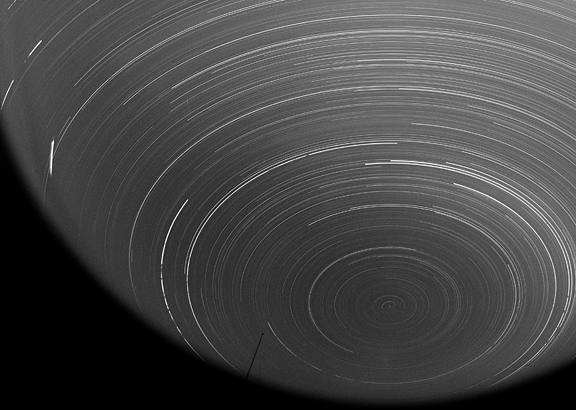Rare Meteorite Found

IMAGE: This is an all-sky image from the easternmost station in the Desert Fireball Network showing the track of the fireball on the left.
CSIRO: Using cameras which capture fireballs streaking across the night sky and sophisticated mathematics, a world-wide team of scientists have managed to find not only a tiny meteorite on the vast Nullarbor Plain, but also its orbit and the asteroid it came from.

IMAGE: This is an all-sky image from the easternmost station in the Desert Fireball Network showing the track of the fireball on the left.
CSIRO: Using cameras which capture fireballs streaking across the night sky and sophisticated mathematics, a world-wide team of scientists have managed to find not only a tiny meteorite on the vast Nullarbor Plain, but also its orbit and the asteroid it came from.
The research team, including CSIRO scientist Dr Rob Hough, was led by Professor Phil Bland of Imperial College London.
The remarkable “detective” work was detailed in a paper published in Science on September 18, 2009.
Meteorites discovered with known orbits are incredibly rare, so the achievement is a remarkable breakthrough in planetary science.
The ability to track meteorites back to their asteroid home also means it is an incredibly cheap way of sampling that asteroid, rather than conducting an expensive space mission.
To find the meteorite, the team deployed three ‘all sky cameras’ on the Nullarbor Plain to form a fireball camera network.
The cameras take a single time lapse picture of the sky throughout the entire night to record any fireballs over the Plain.

IMAGE: This is Bunburra Rockhole, the meteorite, at the discovery site.
Combined with some clever mathematics, researchers were then able to calculate the original orbit of the object and where to search for the meteorite on the ground.
CSIRO Exploration & Mining scientist and co-author of the paper Dr Rob Hough said the search for the meteorite was helped by the fact the Nullarbor Plain is marked by white limestone rocks.
“So a dark meteorite on the white surface is easier to find, however it’s very tiny, so the discovery is still really quite amazing,” Dr Hough said.
“This particular meteorite is also very interesting because of its rarity. It is an achondrite – a basalt – with a composition that suggest an asteroid from the inner asteroid belt.”
Dr Hough said the ‘all sky camera’ network had been an extremely successful project and had spotted many fireballs.
“The Plain is a very difficult place to have technology like the cameras and the fieldwork to find the meteorite is not trivial,” he said.
“The logistics are a really important aspect of a project like this and it takes a lot of planning to make it work.”
The Science paper describes the first find of a meteorite from the camera network.
Western Australia Chief Scientist Professor Lyn Beazley described it as an extremely exciting finding, which will help us understand the evolution of the solar system.
“It will complement Western Australia’s radio astronomy research and, in particular, Australia’s commitment to the Square Kilometre Array radio telescope, ” Professor Beazley said.
“This also represents an extraordinary collaborative effort between CSIRO, the Western Australian Museum and academics from the UK and takes advantage of the unique features of Western Australia, which allows the tracking, locating and collecting of rare meteorite material.”
###
Image available at: http://www.scienceimage.csiro.au/mediarelease/mr09-165.html
Further Information:
Rob Hough, CSIRO Exploration & Mining
Ph:+61 8 6436 8763
E:Robert.Hough@csiro.au
Media Assistance:
Bob Chamberlain,
CSIRO Exploration & Mining
Ph:+61 7 3327 4469
E:Bob.Chamberlain@csiro.au









